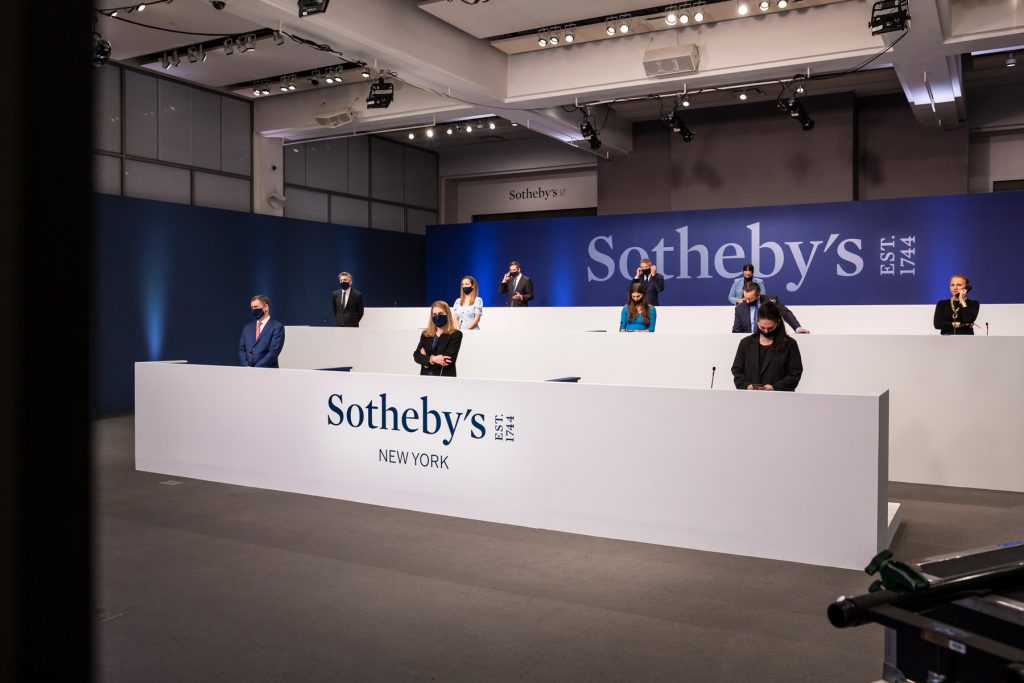
From Living Room to Auction Block: How Art Sells at a Sotheby’s Auction
From Living Room to Auction Block: How Art Sells at a Sotheby’s Auction
Author: Alexandra Steinacker, Sotheby’s Bids Department
When you are involved in the art world in any way, auction houses will be something you hear about often. There are a few, but the two best-known in the fine arts sector are Sotheby’s and Christie’s. Last week, Sotheby’s conducted one of their innovative marquee sales in which live streaming is used to communicate with colleagues and clients all over the world. One auctioneer, located in London, takes bids from telephone bidders in New York, Paris, Hong Kong and London, as well as online.

But how does it get to that point? Having an artwork travel from your living room and end up on the auction block of one of the world’s biggest auction houses is a multi-step process. It begins with a valuation – and many are surprised to learn how straightforward this is. There is an online form you can fill out on the Sotheby’s website, and when the offices are open to the public, there is a valuations desk by the entrance where you can bring your object in, no appointment necessary (this differs depending on location, I am referring specifically to the London New Bond Street office, and it also differs due to current global health regulations). Depending on the valuation, Sotheby’s then decides if they are able to consign the piece.

After that, research is undertaken and catalogue entries are written by the different departments, depending on which sale the consigned work will be offered in. Sotheby’s has over 40 departments, including Contemporary Art, Books and Manuscripts, Old Masters, Watches, Wine, 19th Century European Art, Islamic Art, Chinese Works of Art, and much more. Not only have there been coffee-table-worthy catalogues, but there have been some amazing events and exhibitions that Sotheby’s has put on in the past. For a majority of the sales, the artworks are put on view to the public – free of charge, anyone can walk in and take a stroll through the galleries. There are also Brunches, Talks, and Sotheby’s Lates, which are ticketed (for capacity reasons) where there is often live music, tours, drinks, and more.
At last, the day of the auction comes and the departments need to ensure that all the bids have been registered and paddles are allocated. Clients can bid in the room, online, over the telephone with a specialist, or they can leave an absentee bid which the auctioneer executes on their behalf. The auction room always brims with excitement as the gavel hits the rostrum to signify the commencement of the sale, and it’s as if in a musical performance with everyone working together to create a harmony.

Alexandra Steinacker
The auctioneer must keep in mind a multitude of things, the correct bidding increments (which change depending on the amount) when accepting bids is the tip of the iceberg, all while colleagues on the telephones are calling clients to bid in the room on their behalf. Staff from the relevant specialist departments, the Bids team, Client Services, Technicians, Lighting and Sound, and more, are all involved in the sale, moving in sync to put on each auction as flawlessly as they possibly can.
Of course, there is much more to it, and depending on the circumstances, the process can vary immensely! This brief overview intends to shed a bit of light on the auction process and how a work of art can go from hanging in your living room to being sold at one of the most renowned auctions houses worldwide.

